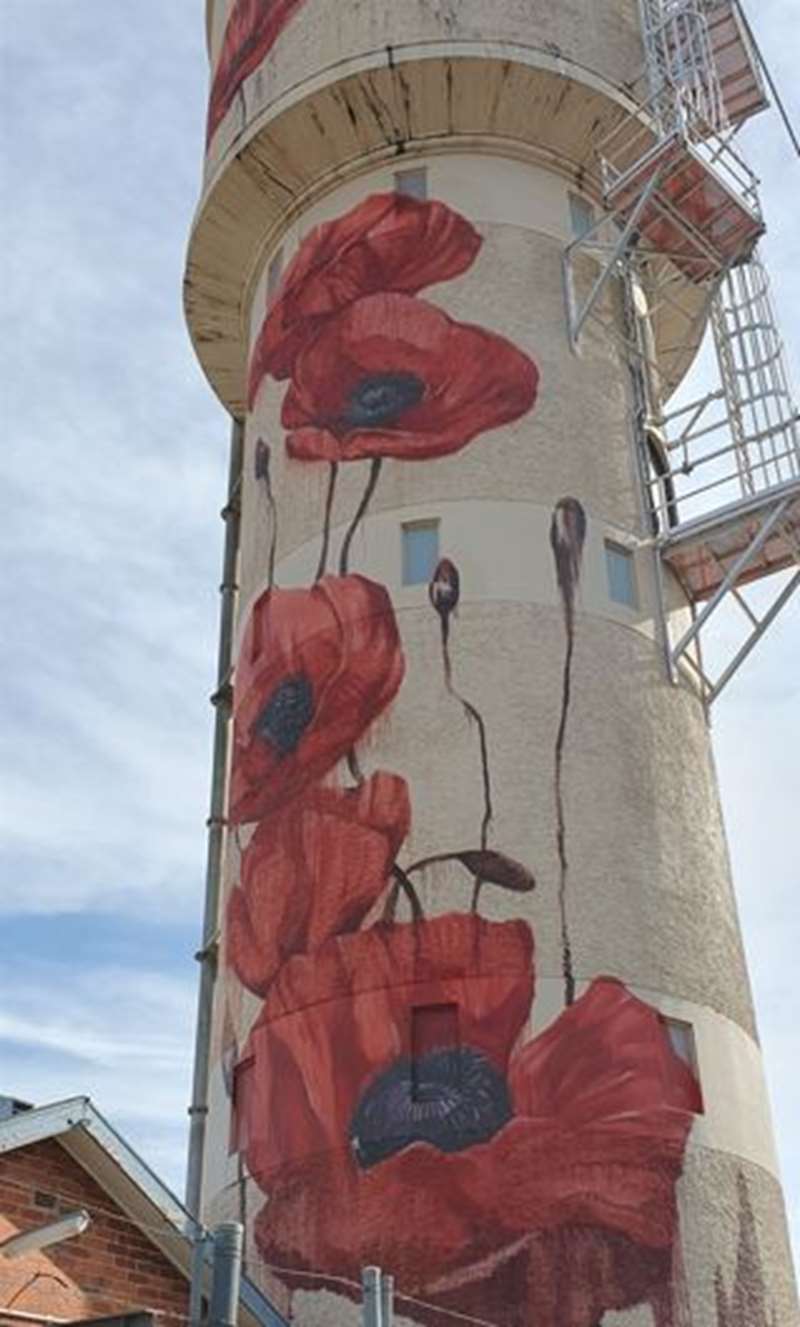Tatura Water Tower Art

The Tatura water tower was designed by Monash, an engineer and Australian military commander in WWI, with the 364,000 litre-capacity tower completed in 1912.
The murals by artists Cam Scale and Andrew Davis pay tribute to Sir John Monash. One side of the tower has remembrance poppies and the other side has a portrait of Sir John Monash.


You can view the tower under lights between 8pm and 10pm daily.
History of Tower
The Tatura Water Tower is the earliest surviving example of a reinforced concrete tower of its type in Victoria. It was designed by Sir John Monash and built by the Reinforced Concrete and Monier Pipe Construction Company.
In May 1911 tenders were called for the design of a concrete standpipe (similar to the standpipes constructed by Monash at Wunghnu and Katamatite). Two days from the deadline, Monash submitted a design for a reinforced concrete tower and tank; a design untested in Australia. The design was approved and work commenced for the sum of 1,559 pounds.
The Tatura Water Tower is 27.7 metres (93 feet) high with a tank capacity of 363,688 litres (80,000 gallons). Its construction trebled Tatura's water pressure compared to the original cast iron tower which can be seen, still standing but not operational, around the corner in Kerferd St. The tower was formally opened on Wednesday 24 April 1912 by Councillor James W. Wilson and and his wife Mrs Mary Wilson, who had the honour of turning on the water.
Many similar towers were constructed across Australia by the Reinforced Concrete and Monier Pipe Construction Company. Remaining fully operational, the Tatura Water Tower is of historic, technological and local significance - a tangible link to the community's water supply history.
In 2012, a century after its construction, the current tower custodian Goulburn Valley Water identified significant weakening of the tank rendering.
Restoration works were carried out to maintain supply and conserve an iconic piece of Tatura's heritage.
1n 2021, a mural was painted on the tower by artist Cam Scale to honour the significant civil contribution of Sir John Monash. It was unveiled on Sunday 27 June 2021 by the Hon. Mark Gepp, Member for Northern Victoria, and Michael Bennett of the Monash family. The mural features a portrait of Sir John Monash and a waterfall of poppies, recognising the area's Anzac legacy.
The mural project was a long-term vision brought to life by Robert Mathieson of the Tatura RSL, with support from the Tatura Rotary Club, Victorian Government and the local community.
John Monash
John Monash was born in Melbourne, Victoria in 1865, the eldest of three children. His parents, Louis and Bertha Monash, immigrated from German Prussia (now Poland). The Monash family moved to Jerilderie, NSW whore John attended Jerilderie Public School in 1875. The family returned to Melbourne in 1877 at the urging of his teacher, for John's education. He was a high achiever, commencing at the University of Melbourne in 1882 when he was just 16 years old, graduating with a bachelor of Arts and Bachelor of Law, Master of Engineering and later, Doctor of Engineering.
In 1891 John married Hannah Victoria Moss, known as Vic. Bertha, their only child, was born In 1893, the same year that John completed his Master of Civil Engineering. John worked as a civil engineer and among, his many achievements, was acknowledged as one of Australia's foremost experts in reinforced concrete for civil construction projects. These included bridges, silos and water tanks - around half of the constructions Monash built (45 in Victoria alone) are still standing.
In 1896 he took up reinforced concrete as an engineering speciality and designed the Morell Bridge (Andersen Street Bridge) over the Yarra River. This was the first Monler arch bridge built in Australia using patented reinforced concrete. It was the forerunner to his long and successful career in reinforced concrete and the basis for the design and engineering of the Tatura Water Tower.
Having been in the militia (now Army Reserve), since university days, when the First World War broke out John Monash was commissioned as a Colonel. He served at Gallipoli, Egypt and the western Front in France. He expertly planned the Battles of Le Hamel and Australia's role In the Battle of Amiens on 8 August, which became the opening phase of the last 100 days of the war.
On 12 August 1918, Lt General John Monash was knighted in the field by King George V at Chateau de Bertangles, the first time a British Monarch had honoured a commander in such a way in 200 years. Monash's victories at Mont St Quentin and Peronne, among other battles, allowed the Allies to breach the Hindenburg line, so ending the war in 1918, not in 1919, as planned by the British and French High command.
He returned to Australia in 1919, and in 1920 his wife Vic died. Later that that year, as first Chairman of the new State Electricity Commission of Victoria, John helped set the foundations for Victoria's economic revival and prosperity following the Great Depression.
General Sir John Monash died on 8 October 1931 in Melbourne from a heart attack. Some 300,000 mourners attended his funeral.
The Monash name lives on in many ways; through the university that bears his name, the John Monash Scholarships awarded to outstanding Australians with Leadership potential wishing to study overseas, and the Sir John Monash Centre, a multimedia educative centre in Northern France.
Location
83 Ross Street, Tatura 3630 View Map








